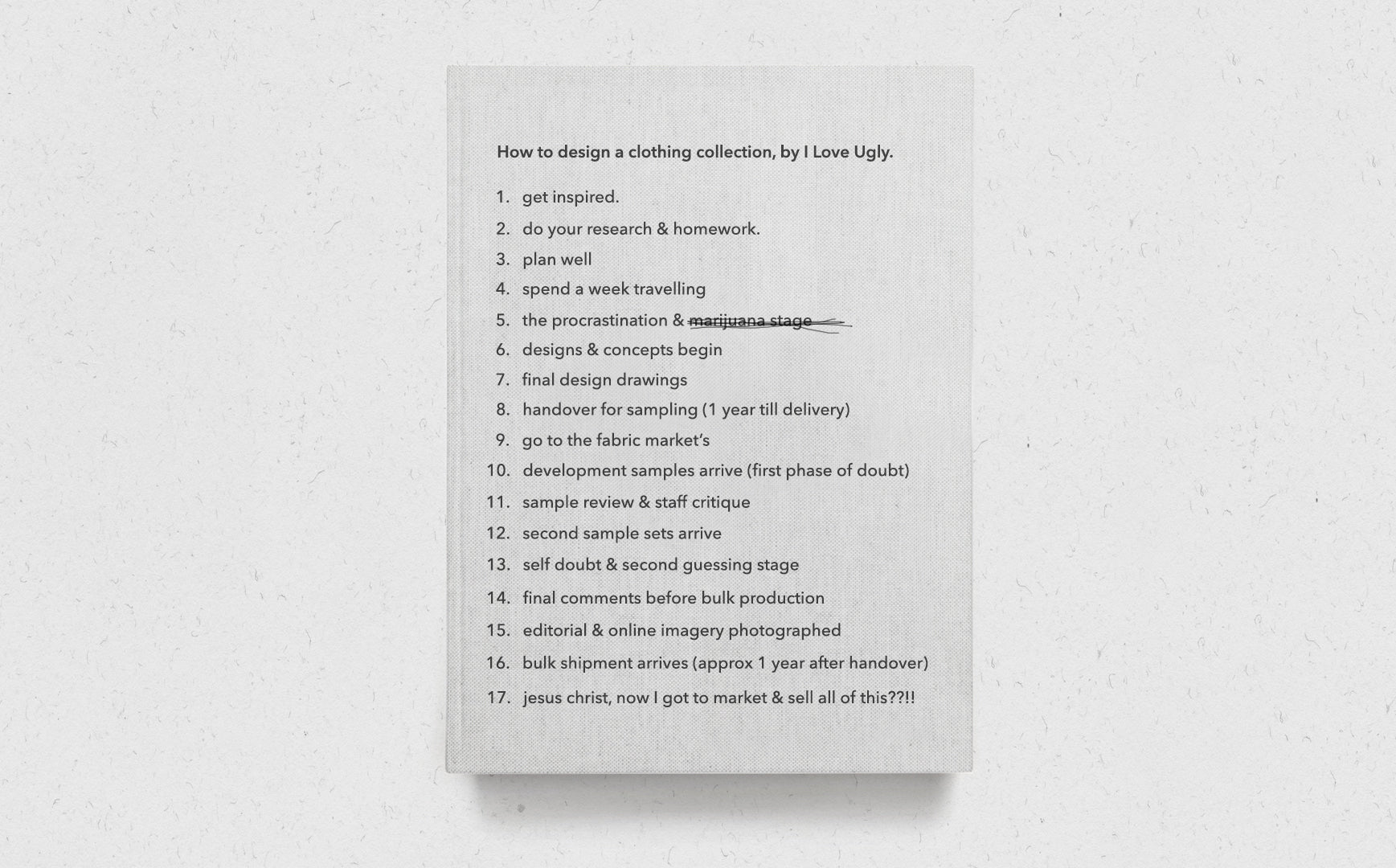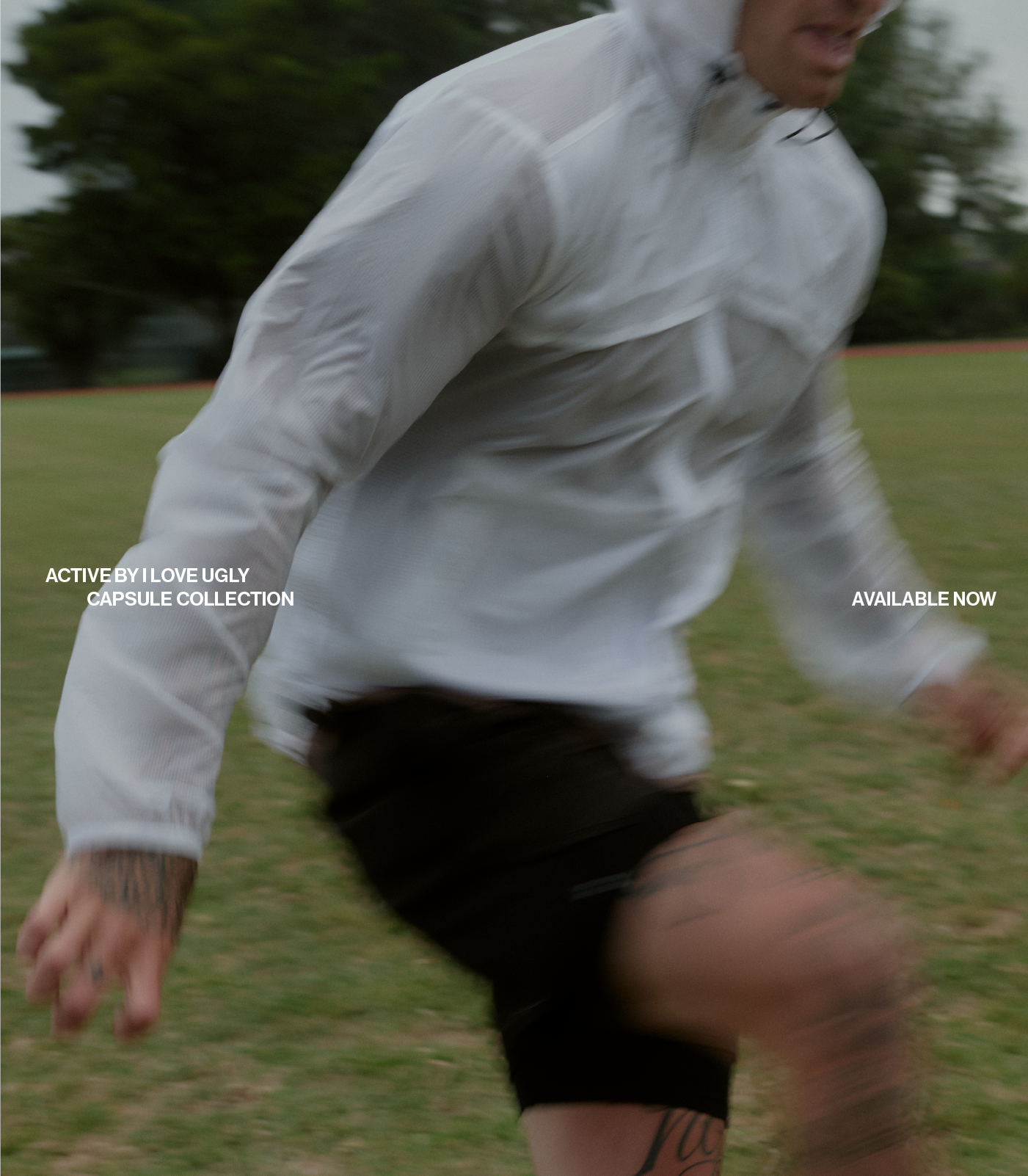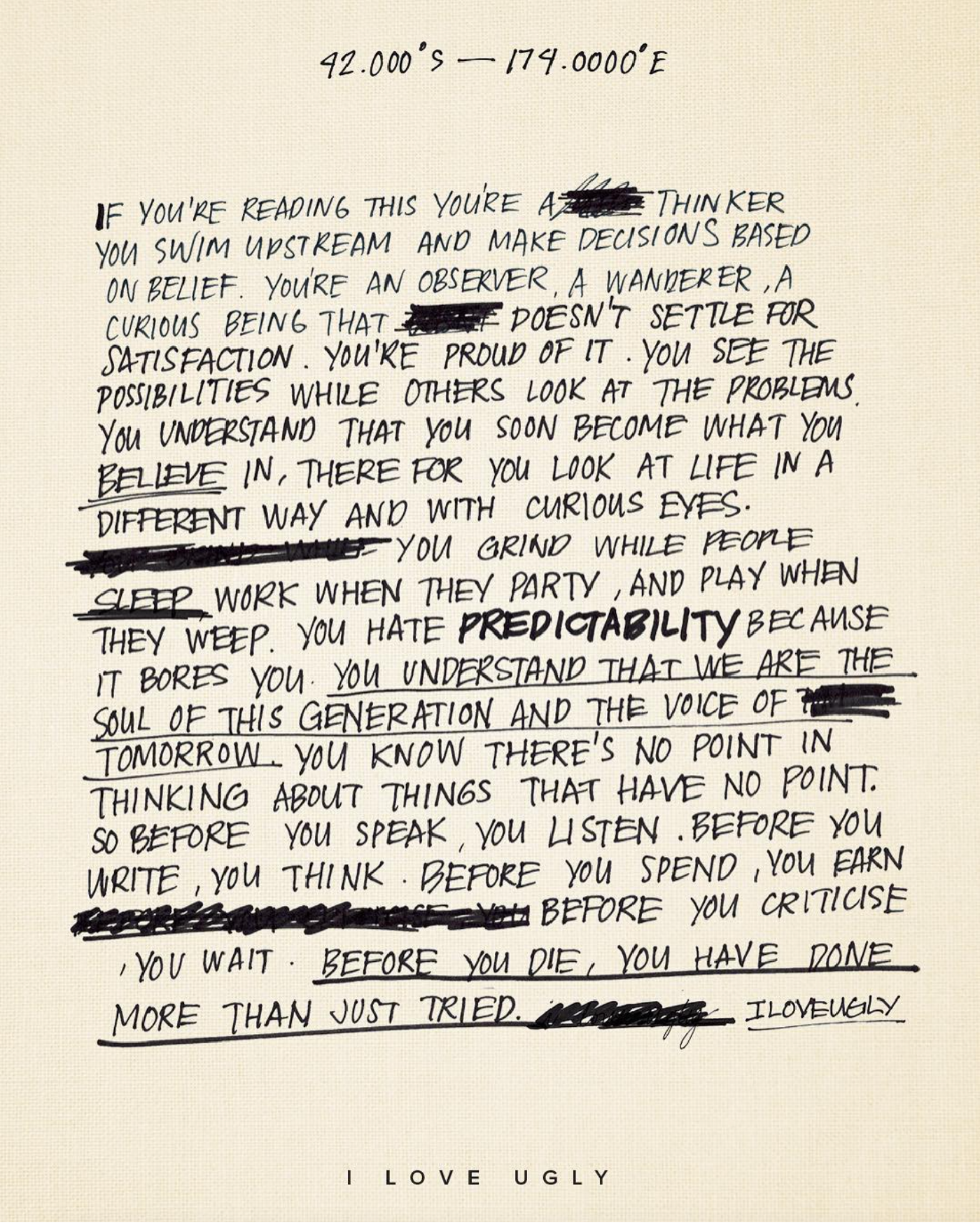
The I Love Ugly Production Process
Some wise guy once said “He who holds information, holds the power” , Well we’re not to sure if this is entirely true, At I Love Ugly we get a real buzz out of exposing the way we do something, having a true transparency through the company so our customer can really get to know the brand and almost become a part of it, so the guy that said “He who holds information, Holds the power” was a selfish prick. So here’s our 17 step process on how we go about designing our product.
1) Get inspired
2) Do your research & homework
3) Plan
4) Spend a week traveling
5) The procrastination and marijuana smoking stage
6) Design Ideas & Concepts (1 month)
7) Final Design Drawings (1 week)
8) Handover for sampling (1 year till delivery)
9) Go to the fabric market’s
10) Development samples arrive/ First phase of Doubt begins
11) Sample review and staff critique (Cycle starts again)
12) Second sample sets arrive (fear & anxiety kicks in)
13) Self doubt and second guessing stage
14) Final comments before bulk production
15) Editorial & online imagery is shot (you can't screw it up at this point)
16) Bulk shipment arrives (approx. 1 year after handover)
17) Jesus christ, now I got to market and sell all of this??!!
1. Inspiration: Before any physical design must start you need to make sure you are going into the process with a clear head and a purpose. Your product will reflect your attitude at this point. For example, if you’re having to force yourself to get into the zone then it's not the best idea to continue until you have that mental drive to carry you through to the end of the process (it’s important that this motivation stays with you until the end so make sure you don’t lose it).
2. Research: Once you’re mentally prepared, first thing to do is research. This is by far the most important step that can make and break a collection. Yes, it does mean homework ( a lot of homework). Compile vast amounts of research from everything from complete garment ideas, fabric techniques, construction ideas right down to more abstract sources of inspiration like paintings that can spark a certain color scheme or a piece of furniture that inspires a certain form or shape that you could carry into a product. The limitations on what to research and where to research are endless, from the internet to the library even down to sitting on a park bench and simply people watching. However the key to successful research is making sure you literally record every idea down when you think of them, whether it’s a photo of someone on the street (try not look like a creep though), sketching an idea, or a screenshot. Figure the best way to document your research so you can shift through it when needed. Remember the 3 R’s: Research, Record & Revisit (completely just made that one up, doesn’t sound too bad though).
3. Data Analysis & planning: This third step will make more sense to the right-side-brainers, those people that get a kick out of an excel spreadsheet rather than a mood-board. Fashion is a business so therefore you need to make sure you are creating products that fit both a need a want and a reaction, and mostly importantly, products that actually sell. You need to create a plan that roughly outlines each style in terms of their purpose (not the look or style) then you have some rough bones to come back to while designing.
A perfect collection is when there is a perfect balance of ready-to-wear and fashion forward pieces, those pieces that allure the media attention and more fashion forward clientele and then those pieces that are more of a no-brainer and you can push a lot more units in (those pieces keep the banks happy and the lights on).
4. Travel Inspiration: This step is a bit of a luxury that not everyone has and not something everyone constantly does, but when you do get the chance, it tends to pay off in the long term. It is a worthy investment. Luckily we are blessed with being in the position where we can afford to see parts of the world that spark immense amounts of drive and put the love back into what we do (travel is the best form of education by a long shot!). Due to us being based in New Zealand and so far away from the rest of the world we travel to parts of the world with concentrated sources of inspiration, from stores, museums, architecture and right down the people you meet and the food you eat. A trip that can last 5 days is powerful enough to inspire 5 months of products if done right.
5. Procrastination: stop feeling sorry for yourself. Procrastination is just a form of laziness. You have gained momentum by this point, and continuous action fuels motivation, while procrastination kills motivation.
6. Design Ideas & Concepts: Now its time to put your head down and do the work (the biggest task), there are many ways of designing, find your forte and get the job done, whether it's in a team or you take the more lone ranger approach whatever works is fine. Remember this part is tough. Alot of people stop at this point because it’s when the challenge of creating something great kicks in.
By combining your research folders, the excel plan and a bit of gut instinct you should be able to put together all the necessary elements to create your collection. The way we do it is in various stages. Best start is with a Moodboard. Firstly, compile all your favourite pieces of your research and start creating a bit of a mood & colour scheme for your collection, This becomes super helpful having something to refer each garment idea to, to make sure you are keeping the vibe consistent.
We get our designer to have a crack at the whole collection with what he feels is the way to go then we have multiple meetings where we introduce our creative director and other team members right down to the retail staff to add their own flare into the collection and then the amalgamation of all those people’s ideas (hopefully) creates something exciting.
N.B Just a word of advice to any other designers reading this, learn to let your guard down. Yes, they are your “works” of art but they also need constructive criticism to really make them better. it's so interesting how a pair of fresh eyes can see the range and better it. Also, be wise in whose opinions you take on board. We found there is certain people who are convincing and persuasive in their opinions, but it may not necessarily be the right.
N.B 2. Learn to know when you have done enough, Otherwise you will be victim to the too commonly seen “over design”...not naming any brands.
7. Final Design Drawings: Now its time to convert your design ideas into actual product spec sheets (more detailed technical drawings of each specific garment & their details). This is when it's good to be a bit of a whiz on Adobe Illustrator so you can illustrate your ideas the best and most detailed you can, the more in depth you go at this stage the less likely you will encounter any strange surprises at the first development sample. This also gives you a chance to delve a little deeper on certain details and features of the garment.
8. Handover: Once we have created a Spec Sheet for each product we then hand this information (sketches, research examples, notes etc) all over to our production team to create tech packs that consist of all the garments information such as product patterns, sizing guides, trims and detailing, (All of this is stuff you accumulate over the seasons, if it’s brand new style you will need to start from scratch by creating a pattern). Key to a successful clothing brand is a good production team. Luckily we have an awesome team that are the people that deal directly with our factories and handle the garments complete production journey from development to delivery (and iron out any issues along the way!).
9. Fabric Markets: Now the cool part. Physically being up at the fabric markets wherever they are in the world is a very important step to us, which means we can find exactly what we are looking for. It means getting our hands on the actual fabrics we select for each garment, trims and buttons included. The Markets are crazy, it’s like organised chaos, I’m surprised we haven't had any accidents there due to the erratic scooter driving of the fabric delivery men. Best way to get the most out of your time at the markets is by having a clear list of everything you are after plus an extra set of eyes and hands you can trust, then tick it off one by one, oppose to blindlessly walking around hoping to find something “unique” otherwise you’ll find yourself overwhelmed by staring at huge case of buttons for an hour.
10. Development Samples Stage: For all new those designers working on their debut collections, this is the part you will get a bit of a natural euphoric high from, (it’s also the bit that shows how well you did step 7!) This step does however possibly come with disappointment and doubt. Be prepared & brave enough to scrap an idea if it just aint working. You got to be proud of the stuff you didn't do, as much as the stuff you did do. (Success is saying ‘no’ to a 1000 things). But now our ideas on paper are now physical fully fledged (rough) garments. Have your eyes open for anything you feel may become an issue down the track, get people to wear test garments firstly and fore-most. Another thing we usually do, is sleep on certain things. Who knows what's going on in your head when you first encounter a garment that not be the expected result.
11. Sample review and staff critique: The key to a successful range is diversity. The range needs to have the ability to attract all sorts of styles, demographics & psychographics, The way of achieving this is by a reviewal process that involves a lot more members of the team, who all have different styles. We have created a couple ways of getting a good grasp how things will sell this early on in the piece. One of our techniques is we lay out all the designs on their design sheets on a table. We then have multiple people (the more the merrier) pretend they are going shopping and only have a budget that allows them to purchase max 5 pieces. From this you can tally up which garments are the obvious winners and which ones aren’t (swallow your pride as this is when you need to have tough skin). This step also helps dictate your unit ordering down the track. After you have all the necessary information from a wide range of people you then apply the changes at your next fit meeting. (When you focus more on the fit and silhouette of the garment oppose to details etc). We feel we get more honest and straight up feedback if we arent in the room and its not being dictated by anyone, that way they can write down exactly what they are feeling without feeling the need to say yes to a product just because we are in the room.
12. Secondary Samples: When dealing with multiple different styles new & repeats, you will encounter the frustration of having to work on quite a large number of samples. Some of our products (I wonder if you can guess which ones) have been through about 7 stages of development sampling. This is theoretically the last chance you have to ditch a style if it just ain’t working. Usually if the sample aint taking a decent shape by the 4th sample, it’s time to bite the bullet and throw it in the bin. Spending too much time means too much money and energy wastage! And ditching a style past this point becomes a bit of a headache as thats when wholesale, distribution etc get involved as they would of already bought into the garment causing a whole lot of unnecessary fuss and stress.
13. Final comments: This is literally the last opportunity to make any changes to the garment. You will be experiencing a bunch of mixed emotions such as: should I have changed certain features? is this going to sell? are people going to like this? etc etc We go through each aspect of the product with a fine tooth comb and make sure we have covered all bases and left no part of the garment un-critiqued. Speak now or forever hold your peace.
14. Self doubt.
15. Imagery: Your product can be the coolest/highest quality product on the market but if you dont properly portray that through imagery no one will ever know. Take your time on this step ( we invest a lot into this) make sure your product is looking flawless in its imagery both online & editorial alike. Editorial is your first impression to the world and the way 95% of people are going to encounter your brand. This is the opportunity you get to portray your products exactly how you want them to be seen. At this stage the designer will be working very closely with the creative director and marketing manager on how we going to make this thing sell. Whether you incorporate elements of your inspiration into the shoot and relate it back to your products, show your products in the environments that you want to see your products in, or you take a more conceptual approach when you are trying to illustrate more of a deeper thought process behind your work. Basically, the options are endless, but like i said this is something you should take slowly and be completely happy with as very few people who see your brand rarely physically interact with it so they judge your product on how it's portrayed.
16. Bulk goods arrive: The work isn't done yet, however you can see the light at the end of the tunnel. When bulk arrives to our warehouse we gather a team to go QC (Quality Control) the bulk shipment just to make sure that the garments we are receiving are that exactly as per the shipping samples we received prior the shipment arriving (Shipping samples as literally one sample randomly plucked from bulk). We are looking out for hoods being stitched to sleeves and zippers opening the wrong way (yes, we have seen it all before). Once the bulk has been approved it’s ready to be dispatched by our warehouse team to our stores, retailers and distributors all over the world. Take it from us, this is where some of worst nightmares have come true. Prints coming back opposite to what we asked for, or the quality coming back that’s not even suitable to given away for free.
17. Marketing: I tell ya, this business is unmerciful. After all this time, money, effort, procrastination, demon fighting, you have to market and sell the stuff. We will leave this part for another post as it's another ball game.
This is obviously a super rough overview of the journey of each of our individual products in the studio at I Love Ugly. We are not saying this is the only way to do it, but how we do it. Fashion is a gruelling business that’s only for the patient and persistent type. You may have an idea right then and there of what you want to wear but remember you’re not designing for yourself, but for the future you and your future customer in 12 months time. The skill is being able to predict where the market will sit in 12 months from now, what will it look like. More importantly what position you will sit in in it. You’re not always going to get it right but the idea is to have that perfect balance of the more fast-fashion pieces assisted with the cutting edge forward thinking pieces. This games 20% mechanics, 80% psychological. However there is one key fact we forgot to put into this process: Back when we hit Step number 10, that’s usually when you have to start the whole process again while simultaneously working through the remaining steps of your other collection and developing a brand new collection. That’s what we meant when we said this cycle doesn’t stop. Also we release 11-12 collections per year, in multiple hemispheres, as well as injection products and collaborations. We still only have a small head office team of 9 people, and only 3 people on our creative team. Hopefully this gives you guys a better idea of the efforts we go through to give you the best possible product and experience. One last thing... to be a little nervous is a good thing; you know you're pushing the limits when you feel that way. Good luck.




Leave a comment
This site is protected by hCaptcha and the hCaptcha Privacy Policy and Terms of Service apply.